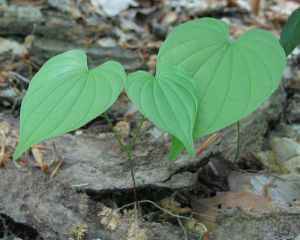It is the ever reliable wild, intoxicating yam prevalent in Leyte’s coconut lands. The locals call it “korot”, the Luzon folks call it “kayos”. It’s scientific name is Dioscorea hispida Dennst. Lore has it that during World War II, when the Japanese occupied Leyte, a lot of them foreign occupiers died, not from bullets nor machetes, but from eating the korot as is. Apparently they tasted the processed and cooked korot from the natives, so they surmised that, as they found them in the forests, it would be safe eating it raw, just like its relative, the sweet yam. So much for ignorance.
A young korot vine sprouting.
The korot itself has an endemic toxin called dioscorine, which causes mild to severe shortness of breath, dizziness, drunkenness in the victim. But there are time tested as well as revolutionary methods of neutralizing the poison. By tradition, the korot is sliced thinly and salted at 20 percent by weight and left to ferment anaerobically for a minimum of six hours, followed by washing in running water for a minimum of four hours. The operative word here is fermentation.
I have done my research and experimentation on a revolutionary way of processing the korot, using a lactobacillus acidophilus starter consisting of an acidophilus tablet, chopped garlic, chopped cabbage (both materials have endemic lactobacilli), coconut water and ten percent sugar by weight. The korot is left to ferment anaerobically in the mixture overnight, after which it is washed in several changes of water and dried mechanically or under the sun. The spent liquor is now devoid of the poison, which is neutralized by the lactic acid bacteria and can be further processed, would you believe, into wine or vinegar, or utilized as animal feed. (Indeed, this is a case of “turning poison into medicine.”)
A freshly picked korot yam
As it is, there are lots of korot growing wild in the coconut plantations of Leyte, Philippines It should be agressively promoted as a regular food and planted extensively under the coconut groves, inasmuch as it thrives in partly shaded areas. Korot chips ready for cooking can be packaged, like rice or pasta by gram or pound and sold in supermarkets, with suggested ways of serving and cooking it. Would you believe that boiled korot goes well with melted cheese, just like your run-of-the-mill “macaroni and cheese” only that korot has more nutritive punch, just like carrots or any other yam?
Sustainability, newness and practicality go to korot cultivation and processing. Any takers?


